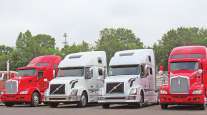Editorial: This Hot Market and Used Trucks
Used trucks are a hot commodity, a reflection of the robust demand for capacity that the trucking industry currently enjoys.
Of note, a story here features comments from an expert who said that fleet buyers of new trucks are not necessarily parting with their old units. Rather, they’re keeping them in service. That’s a far cry from the dark days of the Great Recession, when older trucks were being cannibalized for parts to keep newer ones running. Now, those older trucks are keeping the back office running.
Not only is strong demand for new trucks lifting the value for older units, those values may be compelling some owners to part with their trucks sooner. Arguably, that gets down to basic economics: in a hot market, selling a nicer, pre-owned unit might net the seller a nice return, which can go toward the purchase of a new truck.
That said, a cursory review of traffic along Interstate 81 in Virginia over the Memorial Day weekend proved that older trucks are still on duty. Equipment operated by many of the industry’s medium-size and large fleets tends to skew late-model, but there remain rigs out there with faded paint, duller chrome and telltale signs of engines not equipped with selective catalytic reduction emissions controls.
Trickier to spot are glider kits, which split the difference by installing older, often rebuilt engines in newer bodies. It’s a niche industry caught up in wrangling over how many — and whether — such trucks should be built and permitted onto the roads. The Trump administration moved to end Obama administration-era limits on gliders, and the proposed regulatory rollbacks that followed have compelled industry and governmental representatives to get involved. The most recent developments on what may lie ahead for glider kits are found elsewhere in this issue.
In California, lawmakers approved amendments to toughen standards on smoke opacity, which describes the darkness and thickness of smoke exiting a truck’s exhaust stack. It’s typically a sign of an engine’s age, as any truck producing significant black smoke very likely has a pre-2007 engine. But we’re seeing fewer of them on the roads.
Operators keeping older trucks on the roads are typically doing so for economic reasons. The truck’s still running. But as with any piece of older equipment, the day will come when the economics of spending on repairs for that older truck no longer make sense. So the search will begin for a replacement. Maybe new, maybe used. But, as time passes, fewer of those pre-2007 era models will be available. Attrition is unforgiving, and will, eventually, target the oldest trucks.




